Organizational Behavior Assignment: Weeks 5-12 Analysis and Insights
VerifiedAdded on 2020/05/08
|7
|1738
|51
Homework Assignment
AI Summary
This assignment provides a comprehensive analysis of organizational behavior, covering topics from week 5 to week 12. It begins with an analysis of perception through a film comparison, followed by an examination of motivation strategies employed by successful companies. The assignment then delves into group behavior and team dynamics, exploring case studies on team effectiveness. Leadership theories, including trait and behavioral approaches, are discussed, alongside methods for selecting and developing effective leaders. The impact of power and politics in organizations is assessed through a case study on delegation. The assignment further examines conflict and negotiation strategies, and the role of organizational change, including both sustaining and disruptive innovations. Finally, it explores the cultural relativity of interpersonal skills, motivation, group behavior, leadership style, conflict management, structure, and HRM practices within an organization, drawing on the student's studies over the 11 weeks. The assignment concludes with a list of references used to support the analysis.
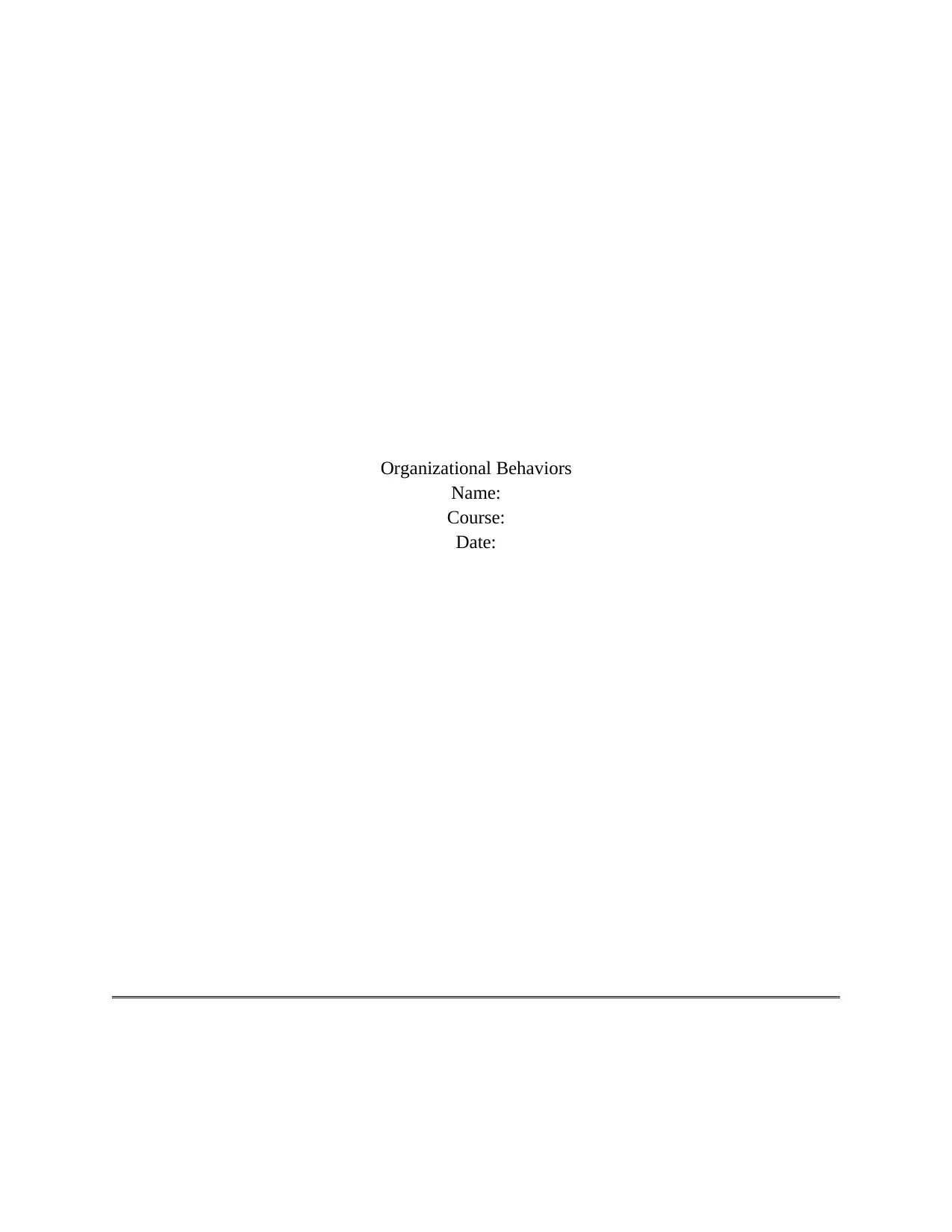
Organizational Behaviors
Name:
Course:
Date:
Name:
Course:
Date:
Paraphrase This Document
Need a fresh take? Get an instant paraphrase of this document with our AI Paraphraser
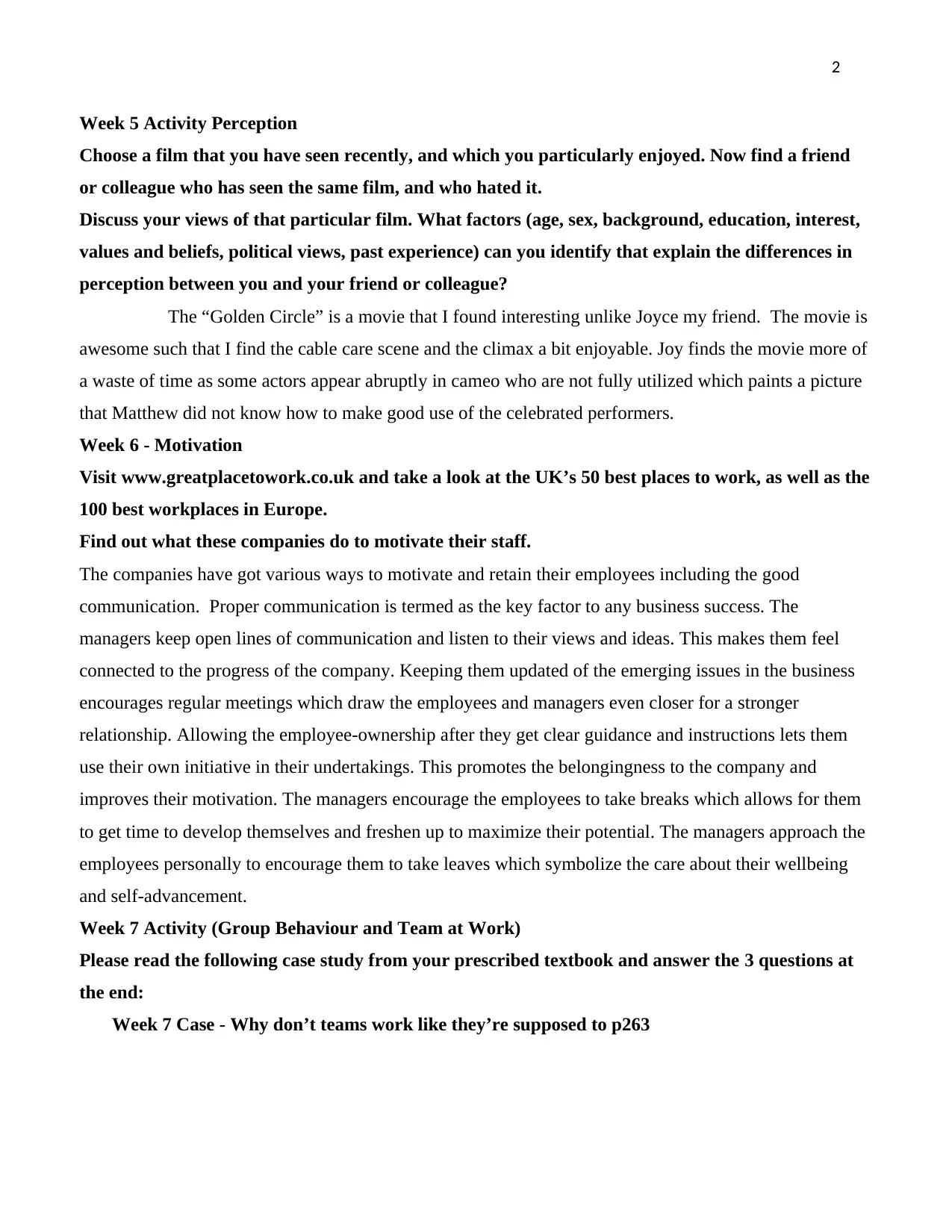
2
Week 5 Activity Perception
Choose a film that you have seen recently, and which you particularly enjoyed. Now find a friend
or colleague who has seen the same film, and who hated it.
Discuss your views of that particular film. What factors (age, sex, background, education, interest,
values and beliefs, political views, past experience) can you identify that explain the differences in
perception between you and your friend or colleague?
The “Golden Circle” is a movie that I found interesting unlike Joyce my friend. The movie is
awesome such that I find the cable care scene and the climax a bit enjoyable. Joy finds the movie more of
a waste of time as some actors appear abruptly in cameo who are not fully utilized which paints a picture
that Matthew did not know how to make good use of the celebrated performers.
Week 6 - Motivation
Visit www.greatplacetowork.co.uk and take a look at the UK’s 50 best places to work, as well as the
100 best workplaces in Europe.
Find out what these companies do to motivate their staff.
The companies have got various ways to motivate and retain their employees including the good
communication. Proper communication is termed as the key factor to any business success. The
managers keep open lines of communication and listen to their views and ideas. This makes them feel
connected to the progress of the company. Keeping them updated of the emerging issues in the business
encourages regular meetings which draw the employees and managers even closer for a stronger
relationship. Allowing the employee-ownership after they get clear guidance and instructions lets them
use their own initiative in their undertakings. This promotes the belongingness to the company and
improves their motivation. The managers encourage the employees to take breaks which allows for them
to get time to develop themselves and freshen up to maximize their potential. The managers approach the
employees personally to encourage them to take leaves which symbolize the care about their wellbeing
and self-advancement.
Week 7 Activity (Group Behaviour and Team at Work)
Please read the following case study from your prescribed textbook and answer the 3 questions at
the end:
Week 7 Case - Why don’t teams work like they’re supposed to p263
Week 5 Activity Perception
Choose a film that you have seen recently, and which you particularly enjoyed. Now find a friend
or colleague who has seen the same film, and who hated it.
Discuss your views of that particular film. What factors (age, sex, background, education, interest,
values and beliefs, political views, past experience) can you identify that explain the differences in
perception between you and your friend or colleague?
The “Golden Circle” is a movie that I found interesting unlike Joyce my friend. The movie is
awesome such that I find the cable care scene and the climax a bit enjoyable. Joy finds the movie more of
a waste of time as some actors appear abruptly in cameo who are not fully utilized which paints a picture
that Matthew did not know how to make good use of the celebrated performers.
Week 6 - Motivation
Visit www.greatplacetowork.co.uk and take a look at the UK’s 50 best places to work, as well as the
100 best workplaces in Europe.
Find out what these companies do to motivate their staff.
The companies have got various ways to motivate and retain their employees including the good
communication. Proper communication is termed as the key factor to any business success. The
managers keep open lines of communication and listen to their views and ideas. This makes them feel
connected to the progress of the company. Keeping them updated of the emerging issues in the business
encourages regular meetings which draw the employees and managers even closer for a stronger
relationship. Allowing the employee-ownership after they get clear guidance and instructions lets them
use their own initiative in their undertakings. This promotes the belongingness to the company and
improves their motivation. The managers encourage the employees to take breaks which allows for them
to get time to develop themselves and freshen up to maximize their potential. The managers approach the
employees personally to encourage them to take leaves which symbolize the care about their wellbeing
and self-advancement.
Week 7 Activity (Group Behaviour and Team at Work)
Please read the following case study from your prescribed textbook and answer the 3 questions at
the end:
Week 7 Case - Why don’t teams work like they’re supposed to p263
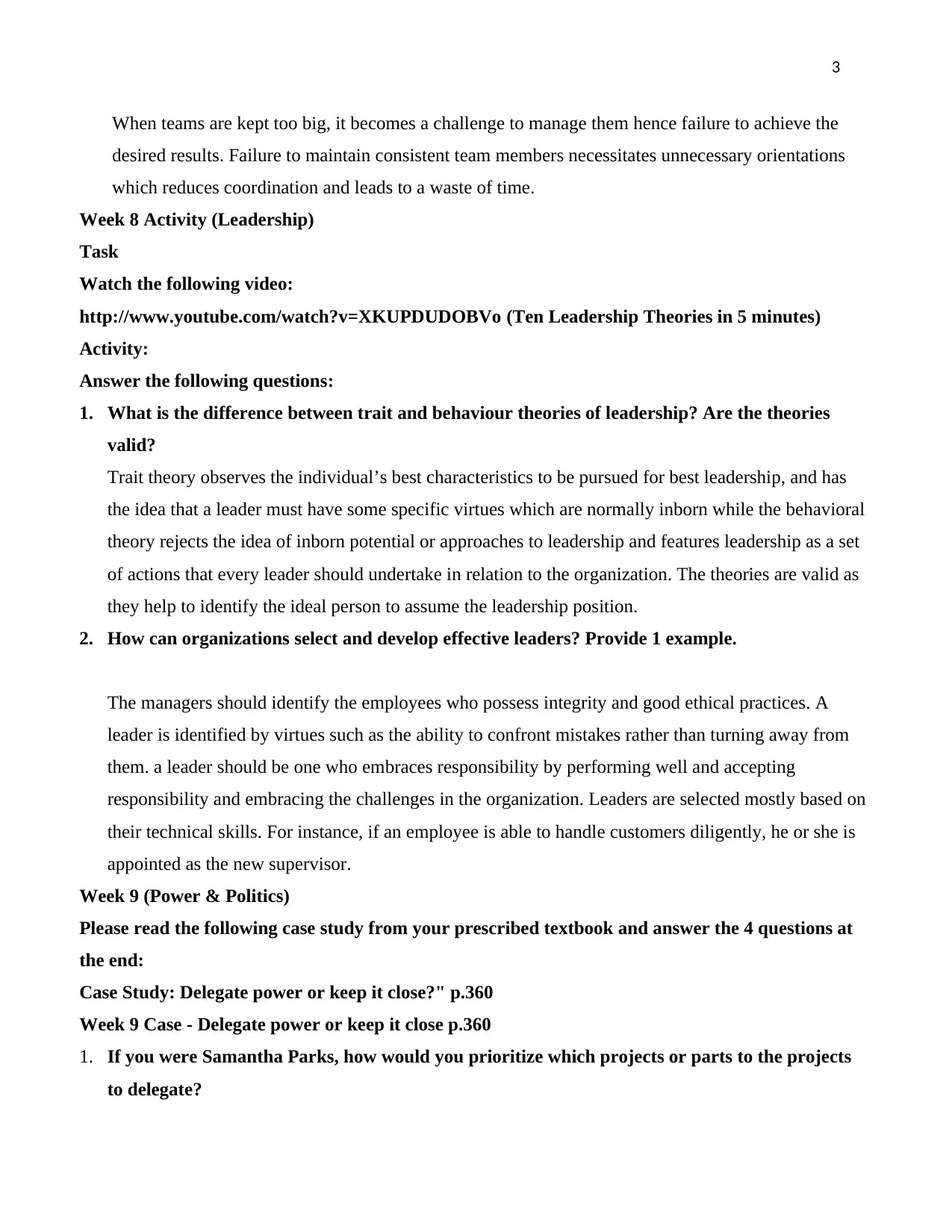
3
When teams are kept too big, it becomes a challenge to manage them hence failure to achieve the
desired results. Failure to maintain consistent team members necessitates unnecessary orientations
which reduces coordination and leads to a waste of time.
Week 8 Activity (Leadership)
Task
Watch the following video:
http://www.youtube.com/watch?v=XKUPDUDOBVo (Ten Leadership Theories in 5 minutes)
Activity:
Answer the following questions:
1. What is the difference between trait and behaviour theories of leadership? Are the theories
valid?
Trait theory observes the individual’s best characteristics to be pursued for best leadership, and has
the idea that a leader must have some specific virtues which are normally inborn while the behavioral
theory rejects the idea of inborn potential or approaches to leadership and features leadership as a set
of actions that every leader should undertake in relation to the organization. The theories are valid as
they help to identify the ideal person to assume the leadership position.
2. How can organizations select and develop effective leaders? Provide 1 example.
The managers should identify the employees who possess integrity and good ethical practices. A
leader is identified by virtues such as the ability to confront mistakes rather than turning away from
them. a leader should be one who embraces responsibility by performing well and accepting
responsibility and embracing the challenges in the organization. Leaders are selected mostly based on
their technical skills. For instance, if an employee is able to handle customers diligently, he or she is
appointed as the new supervisor.
Week 9 (Power & Politics)
Please read the following case study from your prescribed textbook and answer the 4 questions at
the end:
Case Study: Delegate power or keep it close?" p.360
Week 9 Case - Delegate power or keep it close p.360
1. If you were Samantha Parks, how would you prioritize which projects or parts to the projects
to delegate?
When teams are kept too big, it becomes a challenge to manage them hence failure to achieve the
desired results. Failure to maintain consistent team members necessitates unnecessary orientations
which reduces coordination and leads to a waste of time.
Week 8 Activity (Leadership)
Task
Watch the following video:
http://www.youtube.com/watch?v=XKUPDUDOBVo (Ten Leadership Theories in 5 minutes)
Activity:
Answer the following questions:
1. What is the difference between trait and behaviour theories of leadership? Are the theories
valid?
Trait theory observes the individual’s best characteristics to be pursued for best leadership, and has
the idea that a leader must have some specific virtues which are normally inborn while the behavioral
theory rejects the idea of inborn potential or approaches to leadership and features leadership as a set
of actions that every leader should undertake in relation to the organization. The theories are valid as
they help to identify the ideal person to assume the leadership position.
2. How can organizations select and develop effective leaders? Provide 1 example.
The managers should identify the employees who possess integrity and good ethical practices. A
leader is identified by virtues such as the ability to confront mistakes rather than turning away from
them. a leader should be one who embraces responsibility by performing well and accepting
responsibility and embracing the challenges in the organization. Leaders are selected mostly based on
their technical skills. For instance, if an employee is able to handle customers diligently, he or she is
appointed as the new supervisor.
Week 9 (Power & Politics)
Please read the following case study from your prescribed textbook and answer the 4 questions at
the end:
Case Study: Delegate power or keep it close?" p.360
Week 9 Case - Delegate power or keep it close p.360
1. If you were Samantha Parks, how would you prioritize which projects or parts to the projects
to delegate?
⊘ This is a preview!⊘
Do you want full access?
Subscribe today to unlock all pages.

Trusted by 1+ million students worldwide
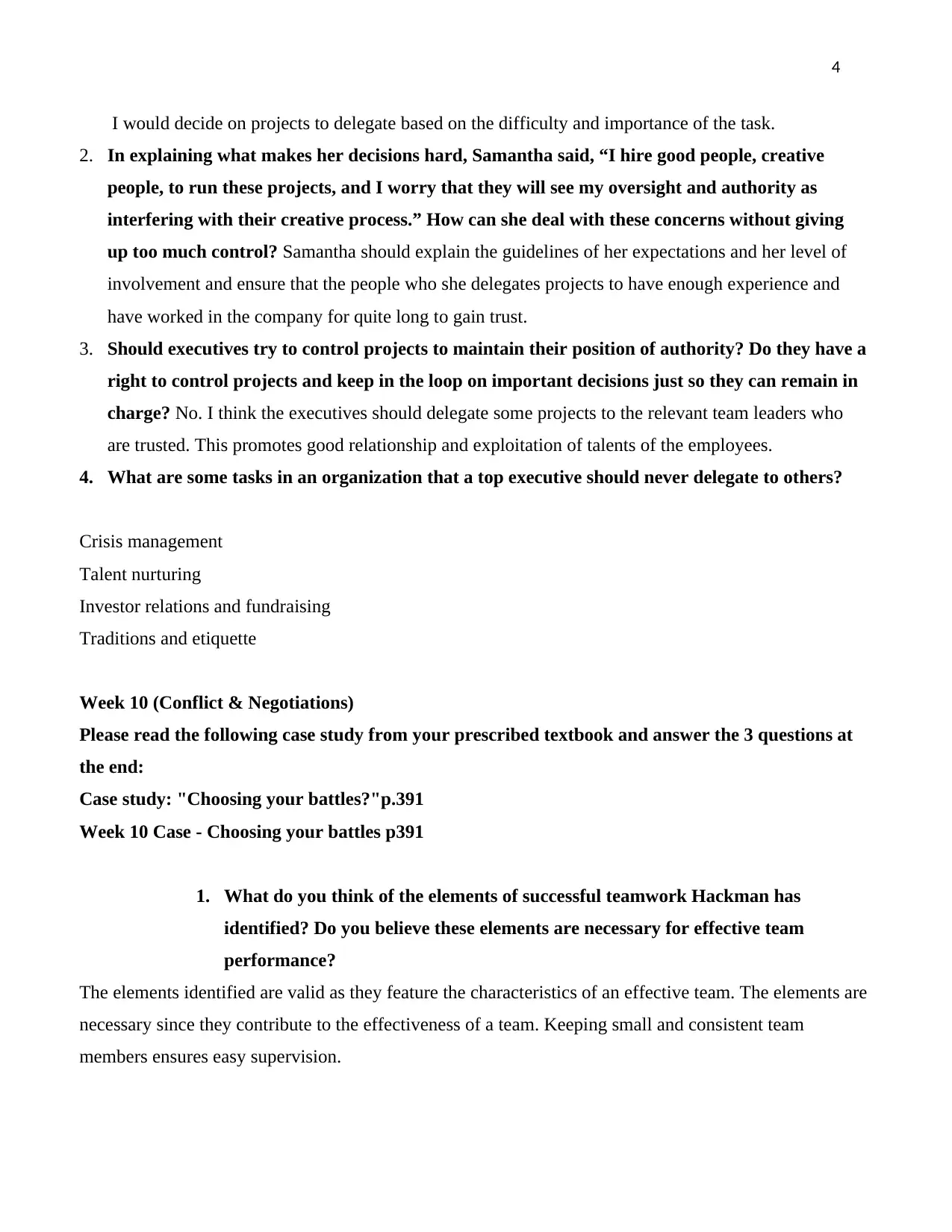
4
I would decide on projects to delegate based on the difficulty and importance of the task.
2. In explaining what makes her decisions hard, Samantha said, “I hire good people, creative
people, to run these projects, and I worry that they will see my oversight and authority as
interfering with their creative process.” How can she deal with these concerns without giving
up too much control? Samantha should explain the guidelines of her expectations and her level of
involvement and ensure that the people who she delegates projects to have enough experience and
have worked in the company for quite long to gain trust.
3. Should executives try to control projects to maintain their position of authority? Do they have a
right to control projects and keep in the loop on important decisions just so they can remain in
charge? No. I think the executives should delegate some projects to the relevant team leaders who
are trusted. This promotes good relationship and exploitation of talents of the employees.
4. What are some tasks in an organization that a top executive should never delegate to others?
Crisis management
Talent nurturing
Investor relations and fundraising
Traditions and etiquette
Week 10 (Conflict & Negotiations)
Please read the following case study from your prescribed textbook and answer the 3 questions at
the end:
Case study: "Choosing your battles?"p.391
Week 10 Case - Choosing your battles p391
1. What do you think of the elements of successful teamwork Hackman has
identified? Do you believe these elements are necessary for effective team
performance?
The elements identified are valid as they feature the characteristics of an effective team. The elements are
necessary since they contribute to the effectiveness of a team. Keeping small and consistent team
members ensures easy supervision.
I would decide on projects to delegate based on the difficulty and importance of the task.
2. In explaining what makes her decisions hard, Samantha said, “I hire good people, creative
people, to run these projects, and I worry that they will see my oversight and authority as
interfering with their creative process.” How can she deal with these concerns without giving
up too much control? Samantha should explain the guidelines of her expectations and her level of
involvement and ensure that the people who she delegates projects to have enough experience and
have worked in the company for quite long to gain trust.
3. Should executives try to control projects to maintain their position of authority? Do they have a
right to control projects and keep in the loop on important decisions just so they can remain in
charge? No. I think the executives should delegate some projects to the relevant team leaders who
are trusted. This promotes good relationship and exploitation of talents of the employees.
4. What are some tasks in an organization that a top executive should never delegate to others?
Crisis management
Talent nurturing
Investor relations and fundraising
Traditions and etiquette
Week 10 (Conflict & Negotiations)
Please read the following case study from your prescribed textbook and answer the 3 questions at
the end:
Case study: "Choosing your battles?"p.391
Week 10 Case - Choosing your battles p391
1. What do you think of the elements of successful teamwork Hackman has
identified? Do you believe these elements are necessary for effective team
performance?
The elements identified are valid as they feature the characteristics of an effective team. The elements are
necessary since they contribute to the effectiveness of a team. Keeping small and consistent team
members ensures easy supervision.
Paraphrase This Document
Need a fresh take? Get an instant paraphrase of this document with our AI Paraphraser
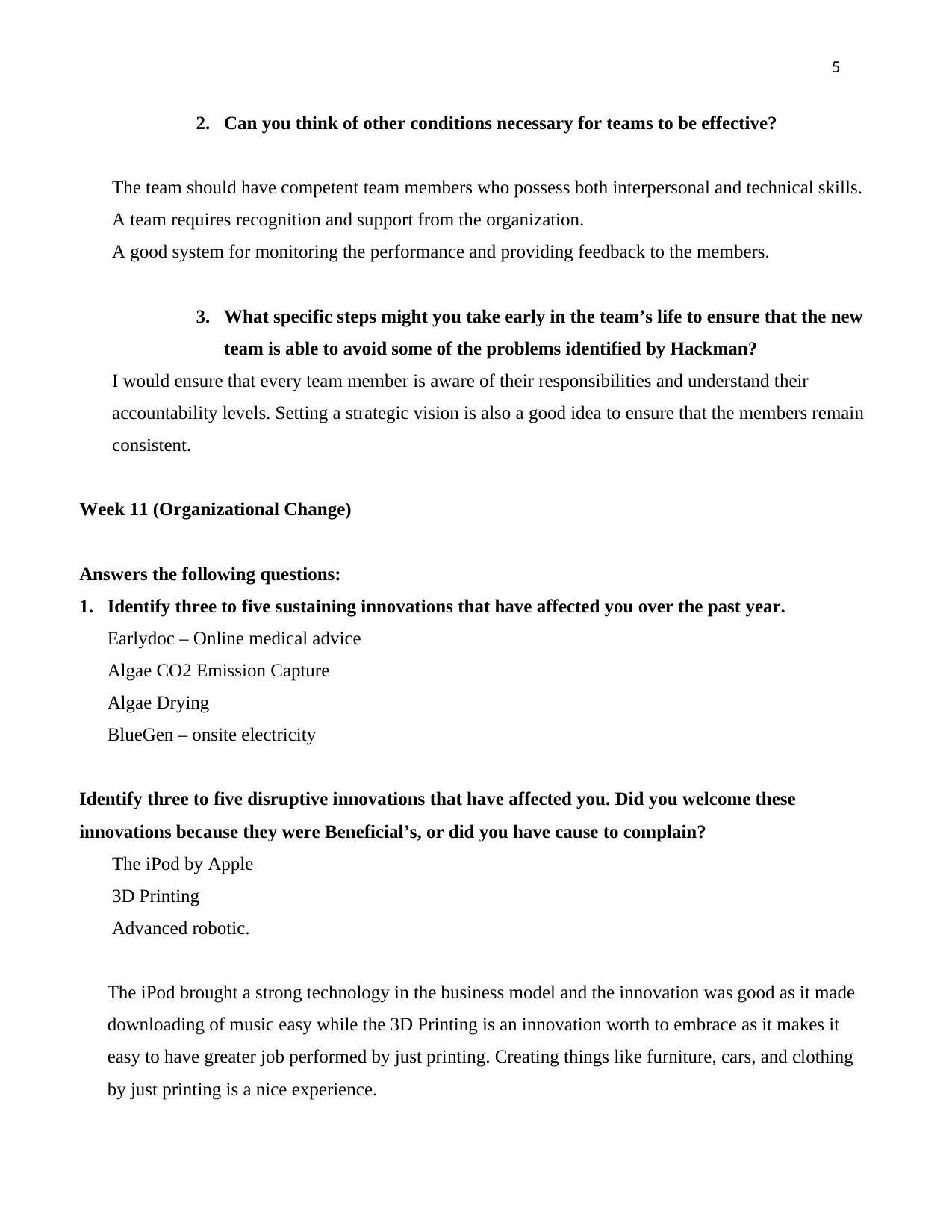
5
2. Can you think of other conditions necessary for teams to be effective?
The team should have competent team members who possess both interpersonal and technical skills.
A team requires recognition and support from the organization.
A good system for monitoring the performance and providing feedback to the members.
3. What specific steps might you take early in the team’s life to ensure that the new
team is able to avoid some of the problems identified by Hackman?
I would ensure that every team member is aware of their responsibilities and understand their
accountability levels. Setting a strategic vision is also a good idea to ensure that the members remain
consistent.
Week 11 (Organizational Change)
Answers the following questions:
1. Identify three to five sustaining innovations that have affected you over the past year.
Earlydoc – Online medical advice
Algae CO2 Emission Capture
Algae Drying
BlueGen – onsite electricity
Identify three to five disruptive innovations that have affected you. Did you welcome these
innovations because they were Beneficial’s, or did you have cause to complain?
The iPod by Apple
3D Printing
Advanced robotic.
The iPod brought a strong technology in the business model and the innovation was good as it made
downloading of music easy while the 3D Printing is an innovation worth to embrace as it makes it
easy to have greater job performed by just printing. Creating things like furniture, cars, and clothing
by just printing is a nice experience.
2. Can you think of other conditions necessary for teams to be effective?
The team should have competent team members who possess both interpersonal and technical skills.
A team requires recognition and support from the organization.
A good system for monitoring the performance and providing feedback to the members.
3. What specific steps might you take early in the team’s life to ensure that the new
team is able to avoid some of the problems identified by Hackman?
I would ensure that every team member is aware of their responsibilities and understand their
accountability levels. Setting a strategic vision is also a good idea to ensure that the members remain
consistent.
Week 11 (Organizational Change)
Answers the following questions:
1. Identify three to five sustaining innovations that have affected you over the past year.
Earlydoc – Online medical advice
Algae CO2 Emission Capture
Algae Drying
BlueGen – onsite electricity
Identify three to five disruptive innovations that have affected you. Did you welcome these
innovations because they were Beneficial’s, or did you have cause to complain?
The iPod by Apple
3D Printing
Advanced robotic.
The iPod brought a strong technology in the business model and the innovation was good as it made
downloading of music easy while the 3D Printing is an innovation worth to embrace as it makes it
easy to have greater job performed by just printing. Creating things like furniture, cars, and clothing
by just printing is a nice experience.
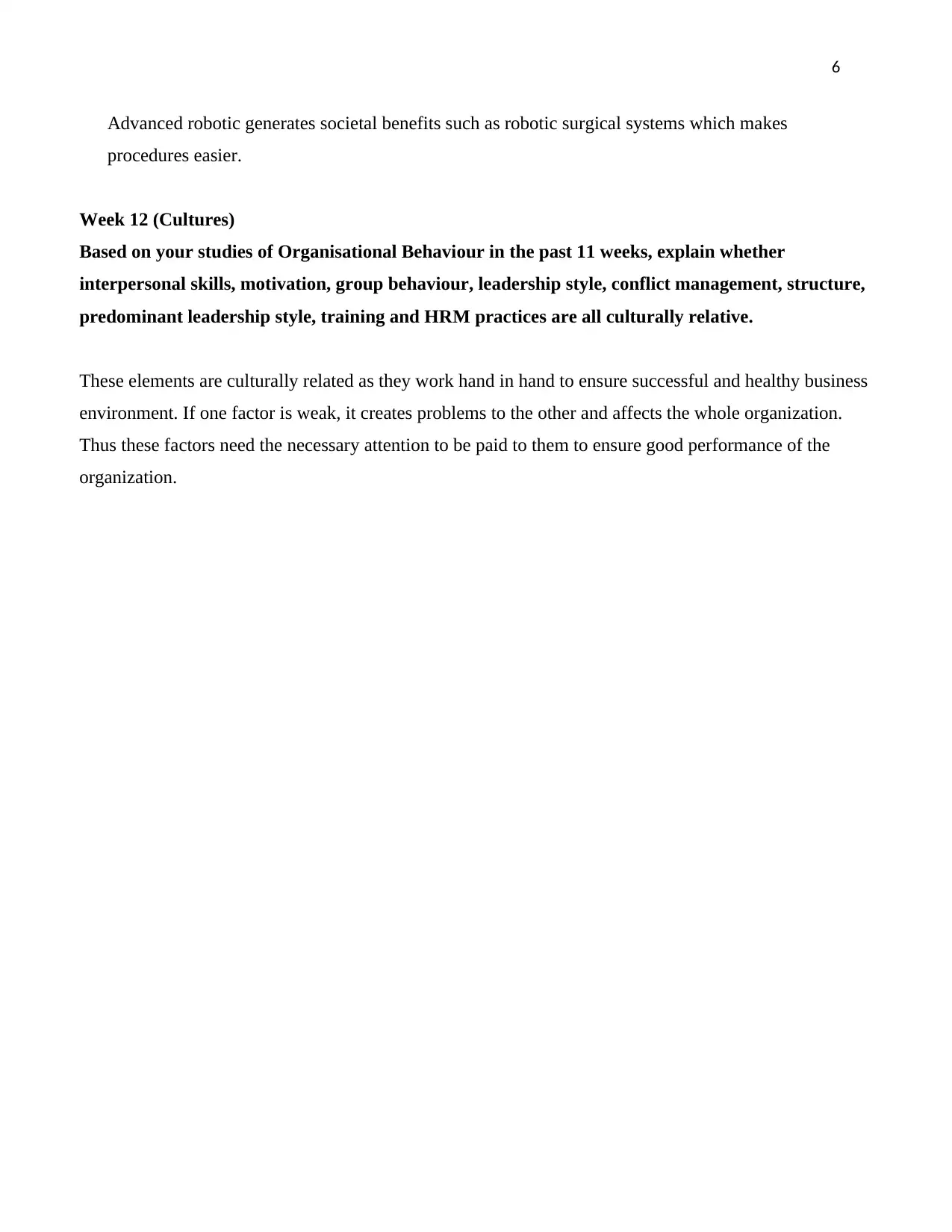
6
Advanced robotic generates societal benefits such as robotic surgical systems which makes
procedures easier.
Week 12 (Cultures)
Based on your studies of Organisational Behaviour in the past 11 weeks, explain whether
interpersonal skills, motivation, group behaviour, leadership style, conflict management, structure,
predominant leadership style, training and HRM practices are all culturally relative.
These elements are culturally related as they work hand in hand to ensure successful and healthy business
environment. If one factor is weak, it creates problems to the other and affects the whole organization.
Thus these factors need the necessary attention to be paid to them to ensure good performance of the
organization.
Advanced robotic generates societal benefits such as robotic surgical systems which makes
procedures easier.
Week 12 (Cultures)
Based on your studies of Organisational Behaviour in the past 11 weeks, explain whether
interpersonal skills, motivation, group behaviour, leadership style, conflict management, structure,
predominant leadership style, training and HRM practices are all culturally relative.
These elements are culturally related as they work hand in hand to ensure successful and healthy business
environment. If one factor is weak, it creates problems to the other and affects the whole organization.
Thus these factors need the necessary attention to be paid to them to ensure good performance of the
organization.
⊘ This is a preview!⊘
Do you want full access?
Subscribe today to unlock all pages.

Trusted by 1+ million students worldwide
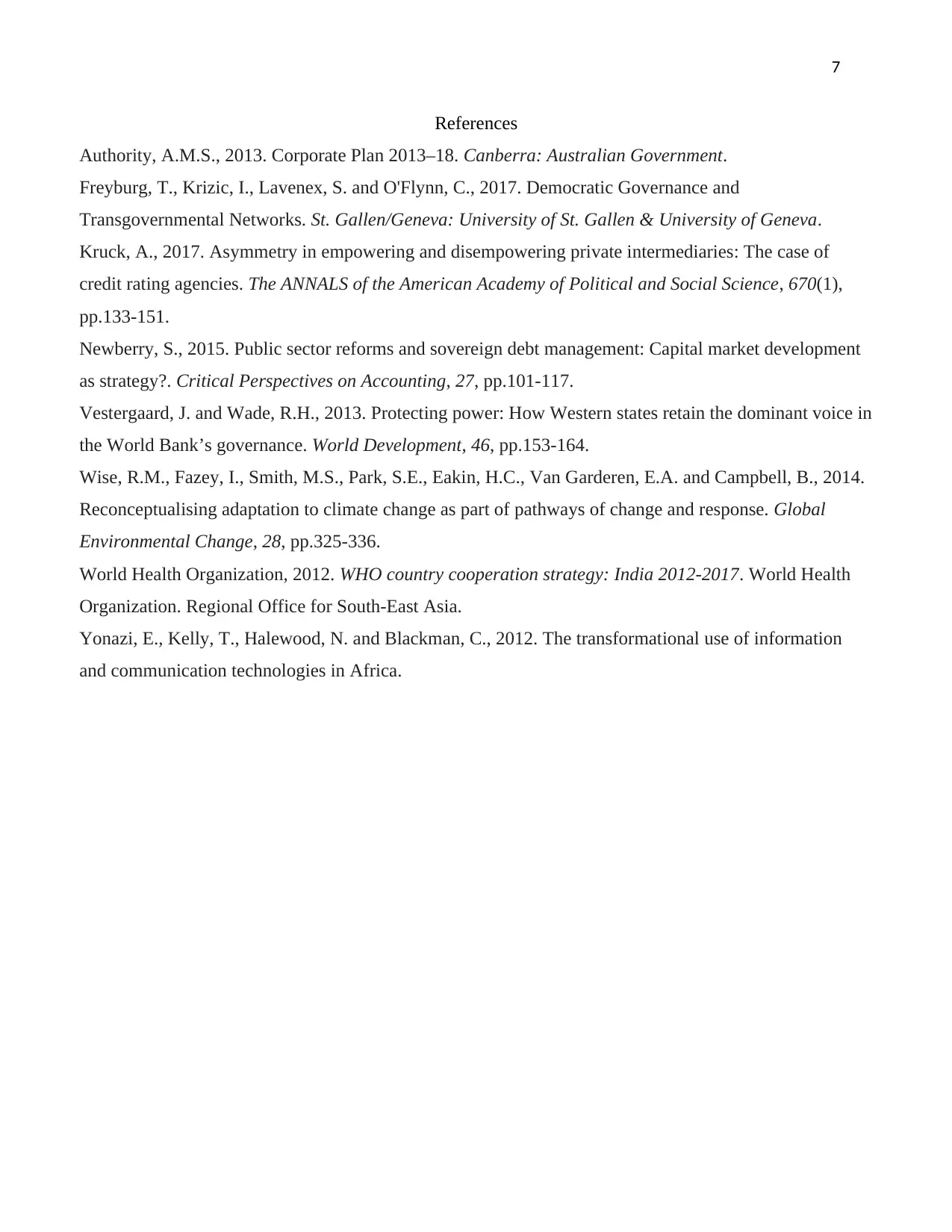
7
References
Authority, A.M.S., 2013. Corporate Plan 2013–18. Canberra: Australian Government.
Freyburg, T., Krizic, I., Lavenex, S. and O'Flynn, C., 2017. Democratic Governance and
Transgovernmental Networks. St. Gallen/Geneva: University of St. Gallen & University of Geneva.
Kruck, A., 2017. Asymmetry in empowering and disempowering private intermediaries: The case of
credit rating agencies. The ANNALS of the American Academy of Political and Social Science, 670(1),
pp.133-151.
Newberry, S., 2015. Public sector reforms and sovereign debt management: Capital market development
as strategy?. Critical Perspectives on Accounting, 27, pp.101-117.
Vestergaard, J. and Wade, R.H., 2013. Protecting power: How Western states retain the dominant voice in
the World Bank’s governance. World Development, 46, pp.153-164.
Wise, R.M., Fazey, I., Smith, M.S., Park, S.E., Eakin, H.C., Van Garderen, E.A. and Campbell, B., 2014.
Reconceptualising adaptation to climate change as part of pathways of change and response. Global
Environmental Change, 28, pp.325-336.
World Health Organization, 2012. WHO country cooperation strategy: India 2012-2017. World Health
Organization. Regional Office for South-East Asia.
Yonazi, E., Kelly, T., Halewood, N. and Blackman, C., 2012. The transformational use of information
and communication technologies in Africa.
References
Authority, A.M.S., 2013. Corporate Plan 2013–18. Canberra: Australian Government.
Freyburg, T., Krizic, I., Lavenex, S. and O'Flynn, C., 2017. Democratic Governance and
Transgovernmental Networks. St. Gallen/Geneva: University of St. Gallen & University of Geneva.
Kruck, A., 2017. Asymmetry in empowering and disempowering private intermediaries: The case of
credit rating agencies. The ANNALS of the American Academy of Political and Social Science, 670(1),
pp.133-151.
Newberry, S., 2015. Public sector reforms and sovereign debt management: Capital market development
as strategy?. Critical Perspectives on Accounting, 27, pp.101-117.
Vestergaard, J. and Wade, R.H., 2013. Protecting power: How Western states retain the dominant voice in
the World Bank’s governance. World Development, 46, pp.153-164.
Wise, R.M., Fazey, I., Smith, M.S., Park, S.E., Eakin, H.C., Van Garderen, E.A. and Campbell, B., 2014.
Reconceptualising adaptation to climate change as part of pathways of change and response. Global
Environmental Change, 28, pp.325-336.
World Health Organization, 2012. WHO country cooperation strategy: India 2012-2017. World Health
Organization. Regional Office for South-East Asia.
Yonazi, E., Kelly, T., Halewood, N. and Blackman, C., 2012. The transformational use of information
and communication technologies in Africa.
1 out of 7
Related Documents
Your All-in-One AI-Powered Toolkit for Academic Success.
+13062052269
info@desklib.com
Available 24*7 on WhatsApp / Email
![[object Object]](/_next/static/media/star-bottom.7253800d.svg)
Unlock your academic potential
Copyright © 2020–2025 A2Z Services. All Rights Reserved. Developed and managed by ZUCOL.





